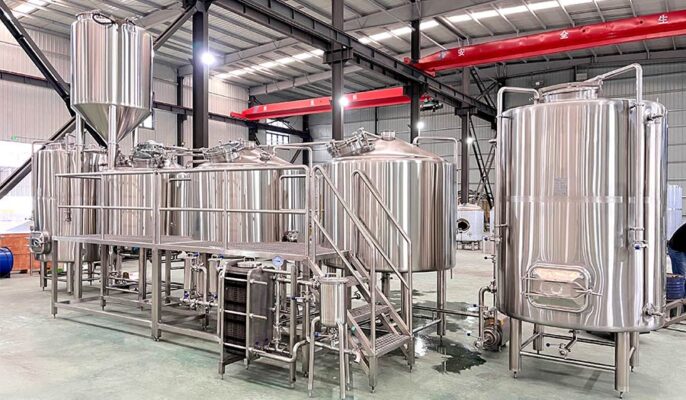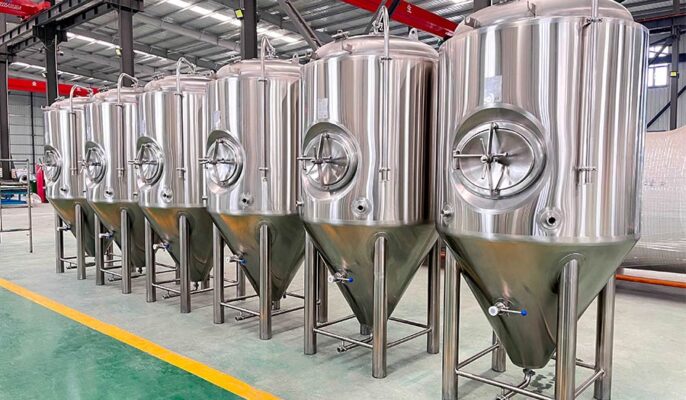Starting a brewery can fulfill the dream of a beer lover or brewer, a dream that can be challenging. The cost of starting a brewery depends on a variety of factors including location, size, equipment, raw materials, human resources, and marketing strategy, to name a few. Therefore, a detailed business plan and budget are required before starting a brewery to accurately assess your investment. In this guide, Micet engineers will explain in detail what costs are involved in starting a successful brewery.
What type of brewery do you choose to start?
Not all breweries are the same, and the cost of brewing equipment can vary greatly depending on several factors, such as the size of the brewery, the type of brewing system, and the specific components needed.
- Nanobreweries: $1,000 to $50,000 Nanobreweries are smaller, typically producing less than 1,000 barrels per year. These systems are a popular choice for startups or brewpubs due to the lower upfront costs.
- Microbreweries: $5,000 to $20,000 Smaller breweries typically produce 1,000 to 15,000 barrels of beer per year. These systems are popular among small and medium-sized independent breweries that distribute their products regionally.
- Regional Breweries: $20,000 to $1,00,000 Regional breweries produce larger volumes of beer, typically 15,000 to 500,000 barrels per year. These systems are more complex and require more investment.
- Large Breweries: $100,000 and up Large breweries produce large volumes of beer, typically more than 500,000 barrels per year. The cost of these systems can run into millions of dollars, depending on size, technology, and automation.

Upfront Costs of a Brewery
- Spatial location: The location of a brewery is a fundamental factor in startup costs. Costs associated with location can vary greatly depending on whether you rent, lease, or buy the space. There are additional costs if you hire a decorator or installer rather than doing the work yourself.
- Equipment and Inventory: You can often save money by purchasing used brewing equipment or bar supplies, but even so, spending money on new, appropriate equipment (including fermenters and kegs) is a long-term commitment. While breweries need to stock grains, hops, and yeast, bars must also stock beer, wine, and spirits.
- licenses and permits: alcoholic beverages require licenses and permits to brew and sell. While fees vary by state and city, initial licensing is usually not optional. If you need the support of a legal professional, you may be paying hundreds of dollars per hour.
- Staff recruitment and training: Initial staffing may cost more than you think. Recruiting highly skilled managers and brewers may require using expensive online platforms or hiring expensive recruiters. Posting and running recruitment campaigns can be expensive.
Équipement de brasserie Costs for Starting a Brewery
Brewery Equipment is a critical step in determining startup costs. Here is a list of essential brewery equipment along with estimated costs:
- Brew Kettles: They are the heart of your operation and can cost anywhere from $20,000 for a small unit to over $100,000 for a larger, more complex system.
- Fermenters: The cost of fermenters varies based on size and material. Budget between $2,000 and $10,000 for each fermenter.
- Milling Equipment: Mills used to grind grains can cost anywhere from $1,000 to $5,000.
- Cooling Systems: Cooling is critical to the brewing process and can range in price from $5,000 for a basic system to $20,000 for a larger system.
- Packaging Equipment: Depending on the packaging method (bottles, cans, or kegs), costs can vary greatly. For example, a bottling line can cost anywhere from $20,000 to $100,000.
- Quality control tools: To maintain the quality of your beer, you need lab equipment, which can cost anywhere from a few thousand dollars to more, depending on the complexity of the equipment.
- Storage tanks: To store raw materials and finished beer, you need storage tanks, which can cost around $5,000 to $15,000 each.
- Pumps, pipes, and valves: These are essential for moving liquids around the brewery and can cost thousands of dollars.
- Cleaning equipment: Proper sanitation is essential, and the investment in cleaning equipment can range from $2,000 to $10,000.
- Brewery control systems: Automation and control systems can require a significant investment, ranging from $10,000 to $50,000 or more.
Factors Affecting Brewery Costs
Brewery Equipment Materials
- Copper Brewing Equipment: Copper brewing equipment has been used for beer brewing for hundreds of years because of its properties. It can quickly and evenly transfer heat to the pot, making the wort boil. Traditionally, people began to brew beer with copper utensils because copper utensils are very suitable for boiling wort at high temperatures.
- Stainless steel brewing equipment: All large commercial breweries use stainless steel brewing equipment in modern times. Although the kettles used there are not completely made of stainless steel, the stainless steel material does not react with chemicals, but it reacts with chlorine, so proper disinfection will not affect the quality of beer brewed by stainless steel brewing equipment. Stainless steel is stronger than copper, so the wort will not be stressed when it boils at high temperatures.
New or second-hand brewery equipment
The production cost of brewery brewing equipment also depends on whether you buy new equipment or second-hand brewing equipment for your startup. Of course, new equipment will be more expensive than second-hand equipment, but if your second-hand commercial brewing equipment is in good condition, it will not affect your brewing at all, before buying it, be sure to check the equipment carefully. New brewery equipment can be purchased with confidence without worrying about other problems, and it can also be used for a longer time.
Brewery Equipment Features
What features you want from your brewery equipment depends on your requirements for your brewing process and products. If your product needs to ferment at low temperatures, you may need a fermenteur that can accurately control the temperature. Specifically, if the beer you brew requires a multi-step mashing process and low-temperature fermentation, you may need a mashing system with advanced temperature control. For example, if you want automated brewing equipment that can save time and labor, this may mean that the cost will be a little higher.

Brewery Equipment Design
The design of the equipment will not only affect its operation and maintenance but also the visual appeal of your brewery. For example, you may want the equipment to have a user-friendly control panel for easy operation. You may also want the equipment to have a unique appearance to attract the attention of your customers. For example, if you want the equipment to be easy to operate, you may want it to have a control panel with clear labels and intuitive controls. The control panel should display all important information, such as temperature, pressure, and flow rate, and should allow you to easily adjust settings. If you want your brewery to stand out, you may want the equipment to have a unique design. This may be a sleek modern design with clean lines and polished surfaces, or a rustic traditional design with copper decorations and wooden details.
Brewery Equipment Supplier
Choosing a reliable brewery equipment supplier is key to customizing your equipment. A good supplier can not only provide high-quality equipment but also provide professional customization services to help you design and manufacture equipment that meets your needs. When choosing a supplier, you need to consider their experience, technical capabilities, service quality, and other factors. For example, Micet Group is a mature team with strong technology. They can meet your customization needs in every aspect.
FAQ
How much does it typically cost to set up a microbrewery?
The cost of building a microbrewery varies widely, ranging from $1,000 for a small home brewing facility to over $80,000 for a commercial brewery, depending on a variety of factors such as size, equipment, and location.
What other costs are associated with setting up a microbrewery?
In addition to equipment costs, microbrewery owners should consider shipping, lifting, and installation fees, and other expenses may include permits, construction, and raw materials.
How long does it take to break even when starting a brewery?
The time it takes for a brewery to break even can vary widely depending on factors such as location, size, and marketing strategy. On average, it can take anywhere from 2 to 5 years for a brewery to become profitable, but this time frame could be shorter or longer depending on your specific situation.
What sustainable practices should I consider for my brewery?
As sustainability becomes more of a priority in the brewing industry, it’s critical to adopt eco-friendly practices such as conserving water, reducing waste, and increasing energy efficiency. These measures not only help minimize environmental impact but also attract environmentally conscious consumers while reducing operating expenses.




